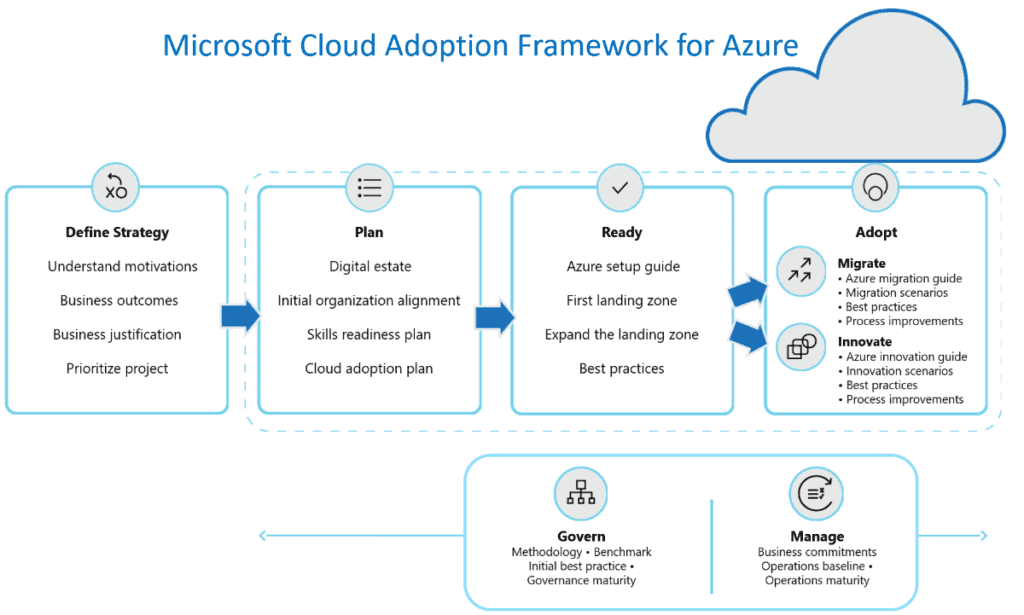The Cloud Adoption Framework is the One Microsoft approach to cloud adoption in Azure, consolidating and sharing best practices from Microsoft employees, partners, and customers. The framework gives customers a set of tools, guidance, and narratives that help shape technology, business, and people strategies for driving desired business outcomes during their adoption effort. This guidance aligns to the following phases of the cloud adoption lifecycle, ensuring easy access to the right guidance at the right time.
Microsoft Cloud Adoption Framework for Azure – Part I: Strategy
First of all, what exactly is the Cloud Adoption Framework? The framework gives customers a set of tools and guidance that help shape technology, business, and people strategies for driving desired business outcomes during their adoption effort. The Cloud Adoption Framework is the One Microsoft approach to cloud adoption in Azure, consolidating and sharing best practices from Microsoft employees, partners, and customers. This guidance consists of six phases which are part of a broad cloud adoption lifecycle, ensuring easy access to the right guidance at the right time. Although the cloud offers tremendous flexibility in design choices, enterprises need a proven and consistent methodology for adopting cloud technologies. The Microsoft Cloud Adoption Framework for Azure meets that need, helping guide decisions throughout cloud adoption. The framework can help them align strategies for business, culture, and technical change to achieve their desired business outcomes. This collection of guides is designed to help Cloud Architects facilitate the right conversations with the right audiences and drive decision-making. Each section of the Cloud Adoption Framework represents a different specialization or variant of the Cloud Architect role. These sections also create opportunities to share cloud architecture responsibilities across a team of Cloud Architects. The following sections align to the flow of the cloud adoption lifecycle visual below. But it is important to note that cloud adoption is iterative (not a sequential process). These competing priorities will emerge (and sometimes reemerge) at various points along your cloud adoption journey.

Strategy
Motivations
The strategy section can help to document your business strategy efficiently. But to achieve the desired outcomes it first should be clear why we are moving to the cloud and what the motivations are behind. Business transformations that are supported by cloud adoption can be driven by various motivations. Some of these are: * Cost savings * Reduction in vendor or technical complexity * Optimization of internal operations * Increase in business agility * Preparation for new technical capabilities * Scaling to meet market demands * Scaling to meet geographic demands One’s motivations for cloud adoption will likely fall into multiple categories. As you’re building the list of motivations, trends will likely emerge. To ensure wiser decision-making, all participants in the migration process should have a clear awareness of their motivations. Business outcomes The most successful transformation journeys start with a business outcome in mind. Understanding projected business outcomes helps facilitate the conversations that you need to have as you document your motivations and supporting metrics, in alignment with your business strategy. During any cloud transformation, the ability to speak in terms of business outcomes supports transparency and cross-functional partnerships. To help you find business outcomes more easily, Microsoft separated them into different categories. Financial or fiscal performance is the cleanest business outcome for many business leaders, but not the only one. Agility outcomes, the ability to respond to and drive market change quickly is the fundamental measure of business agility. In a constantly shrinking market, global reach (ability to support global customers and users) can be measured by compliance in geographies that are relevant to the business. Performance and reliability are assumed. When either falters, reputation damage can be painful and long-lasting. Each of the business outcomes listed in the preceding categories can help facilitate a focused conversation among your business and technical team members. However, you shouldn’t limit your conversations to these generic samples. Of course, it can be difficult to bridge the gap between business and technical conversations. That’s why the business outcome template can help teams uniformly capture business outcomes to be used later in the development of customer transformation journey strategies. The business outcome template spreadsheet can be downloaded to begin brainstorming and tracking business outcomes. The business outcome template focuses on simplified conversations that can quickly engage stakeholders without getting too deep into the technical solution. By rapidly understanding and aligning the key performance indicators (KPIs) and business drivers that are important to stakeholders, your team can think about high-level approaches and transformations before diving into the implementation details. In an effective discovery processes, five key aspects of the business outcome are considered before leading a transformation journey, as shown in the following image:

Business justification
Cloud migrations can generate early return on investment (ROI) from cloud transformation efforts. Developing a clear business justification with tangible, relevant costs and returns can be a complex process. But first, let’s dispel a few myths about cloud migration, so your organization can avoid some common mistakes.
- It’s commonly believed that operating a datacenter in the cloud is always cheaper than operating one on-premises. While this assumption might generally be true, it’s not always the case. These higher costs are often caused by poor cost governance, misaligned system architectures, process duplication, atypical system configurations, or greater staffing costs.
- Mirroring my on-premises environment will help me save money in the cloud. During digital estate planning, it’s not unheard of for businesses to detect unused capacity of more than 50% of the provisioned environment. If assets are provisioned in the cloud to match current provisioning, cost savings are hard to realize. Consider reducing the size of the deployed assets to align with usage patterns rather than provisioning patterns.
- Everything should go into the cloud. In fact, some business drivers might lead you to choose a hybrid solution. Before you finalize a business model, it’s smart to complete a first-round quantitative analysis.
- Moving to the cloud is like flipping a switch. Migrations are a manually intense technical transformation. When developing a business justification, especially justifications that are time sensitive, aspects like bandwidth limitations, testing timelines and migration timelines which increase the time it takes to migrate assets should take into consideration.
At the highest level, the formula for business justification is simple. But the subtle data points required to populate the formula can be difficult to align. On a basic level, the business justification focuses on the return on investment (ROI) associated with the proposed technical change. The generic formula for ROI is:

Financial models and business justifications tend to vary for different organizations. That’s why it is important to establish some formulas and points out a few things that are commonly missed when strategists create financial models. The above formula return on investment (ROI) is often used to compare different ways to invest limited capital resources. Initial investment is the capital expense and operating expense required to complete a transformation. The classification of costs can vary depending on accounting models and CFO preference. But this category would include items like professional services to transform, software licenses used only during the transformation, the cost of cloud services during the transformation, and potentially the cost of salaried employees during the transformation. Calculating the gain from investment often requires a second formula that’s specific to the business outcomes and associated technical changes. Calculating earnings is harder than calculating cost reductions.

Additional Consideration
The core objective of the Strategy methodology is to develop alignment amongst stakeholders. Once defined, that aligned strategic position will drive behaviors throughout each of the methodologies to ensure that technical decisions align desired business outcomes. Fostering alignment amongst stakeholders creates a common set competing priorities: Depth of justification versus Time to business impact. Stakeholders often want a deep financial analysis and full business justification to be comfortable aligning to a strategic direction. Unfortunately, that level of analysis may require an extended time period to allow for data collection and analysis.
About the Author:
I am Matthias Gessenay, and I am a Microsoft MVP for Azure, Microsoft Certified Trainer and Azure Architect for Corporate Software. I am in IT for about 20 years, and dealing with Azure since about six years. I am passionate about community and run four Meetup groups.
Reference:
Gessenay, M. (2020). Microsoft Cloud Adoption Framework for Azure – Strategy (Part I). Available at: https://cloudspeed.ch/post/azure-cloud-adoption-framework-part1/ [Accessed: 19th May 2020].
Check out more great Azure content here











